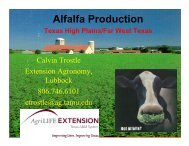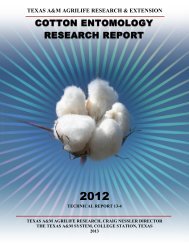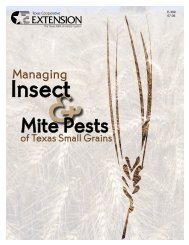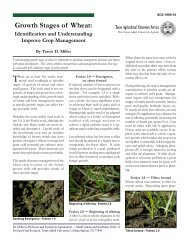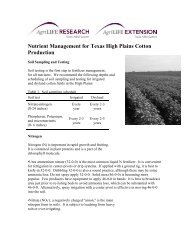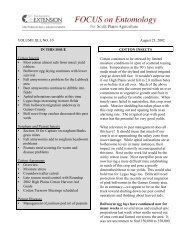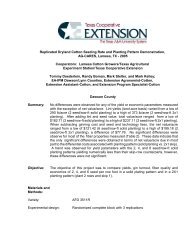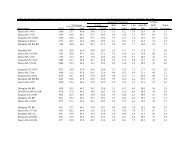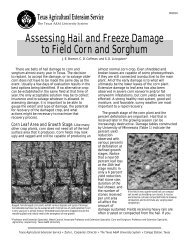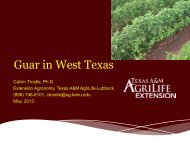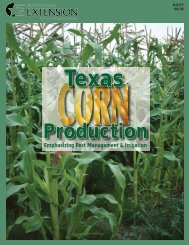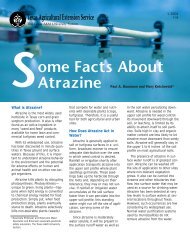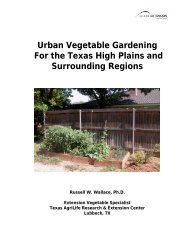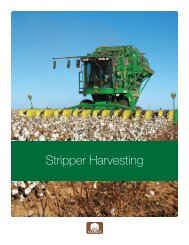Systems Agronomic and Economic Evaluation of Cotton Varieties in ...
Systems Agronomic and Economic Evaluation of Cotton Varieties in ...
Systems Agronomic and Economic Evaluation of Cotton Varieties in ...
Create successful ePaper yourself
Turn your PDF publications into a flip-book with our unique Google optimized e-Paper software.
<strong>Agronomic</strong> <strong>and</strong> <strong>Economic</strong> <strong>Evaluation</strong> <strong>of</strong> <strong>Cotton</strong> <strong>Varieties</strong>January 2013Dr. Mark Kelley, Extension Agronomist - <strong>Cotton</strong>Mr. Chris Ashbrook, Extension Assistant - <strong>Cotton</strong>Texas A&M AgriLife Extension ServiceLubbock, TXIntroductionSmall-plot cotton variety test<strong>in</strong>g generally <strong>in</strong>cludes evaluation <strong>of</strong> genetic components but notgenetics <strong>in</strong> concert with management programs. Characteristics commonly evaluated <strong>in</strong> smallplottest<strong>in</strong>g <strong>in</strong>clude l<strong>in</strong>t yield, turnout percentages, fiber quality, <strong>and</strong> earl<strong>in</strong>ess. Over the lastseveral years, High Pla<strong>in</strong>s cotton producers have <strong>in</strong>creased planted acreage <strong>of</strong> transgeniccotton (glyphosate- <strong>and</strong> glufos<strong>in</strong>ate-herbicide tolerant <strong>and</strong> Bt <strong>in</strong>sect-resistant types) fromapproximately 300 thous<strong>and</strong> <strong>in</strong> 1997 to approximately 3 million <strong>in</strong> 2010.Industry cont<strong>in</strong>ues to <strong>in</strong>crease the number <strong>of</strong> herbicide-tolerant, <strong>in</strong>sect-resistant, <strong>and</strong> "stackedgene" varieties. Liberty L<strong>in</strong>k Ignite herbicide-tolerant varieties (from Bayer CropScience) werefirst marketed <strong>in</strong> 2004. The first commercial "stacked Bt gene" system (Bollgard II fromMonsanto) was launched <strong>in</strong> 2004. <strong>Varieties</strong> conta<strong>in</strong><strong>in</strong>g Monsanto=s Roundup Ready Flex genesystem were commercialized <strong>in</strong> 2006. Widestrike "stacked Bt gene" technology from DowAgroSciences was available <strong>in</strong> some PhytoGen varieties <strong>in</strong> 2005, with additional RoundupReady Flex "stacked" types <strong>in</strong> the market <strong>in</strong> 2006. Liberty L<strong>in</strong>k with Bollgard II types were alsocommercialized <strong>in</strong> 2006. In 2011, Bayer CropScience made Glytol <strong>and</strong> Glytol stacked withLiberty L<strong>in</strong>k available to producers <strong>in</strong> limited quantities. Furthermore, <strong>in</strong> 2012, Bayer <strong>in</strong>troducedseveral Glytol/Liberty L<strong>in</strong>k varities stacked with Bollgard II technology. New transgenic varietiescont<strong>in</strong>ue to be marketed <strong>in</strong> the High Pla<strong>in</strong>s by All-Tex, Americot/NexGen, Croplan Genetics,Delta <strong>and</strong> P<strong>in</strong>e L<strong>and</strong>/Monsanto, Dyna-Gro, the Bayer CropScience FiberMax/Stoneville br<strong>and</strong>s,<strong>and</strong> the Dow AgroSciences PhytoGen br<strong>and</strong>. More transgenic varieties are expected to bereleased by these companies <strong>in</strong> the future. Additional cotton biotechnologies are alsoanticipated <strong>in</strong> the near future. These technologies <strong>in</strong>clude Extend from Monsanto/Deltap<strong>in</strong>e <strong>and</strong>Enlist from Dow AgroSciences/PhytoGen. Extend technology with impart resistance to threeherbicide molecules, dicamba, glyphosate, <strong>and</strong> glufos<strong>in</strong>ate. <strong>Varieties</strong> with Enlist technology willbe resistant to a new formulation <strong>of</strong> the 2,4-D herbicide. The proliferation <strong>of</strong> transgenic varieties<strong>in</strong> the marketplace is expected to cont<strong>in</strong>ue over the next several years.Current small-plot variety test<strong>in</strong>g programs are <strong>in</strong>adequate <strong>in</strong> scale <strong>and</strong> design to <strong>in</strong>vestigate theeconomic impact <strong>of</strong> new transgenic varieties with value-added traits. The objective <strong>of</strong> thisproject was to evaluate the pr<strong>of</strong>itability <strong>of</strong> cotton varieties <strong>in</strong> producers' fields <strong>in</strong> the Texas HighPla<strong>in</strong>s.Materials <strong>and</strong> MethodsFor scientific validity, three replications <strong>of</strong> each variety were <strong>in</strong>cluded at the Farwell <strong>and</strong> Pla<strong>in</strong>slocations, with four replications <strong>in</strong>cluded at Blanco. In previous years, plots were <strong>of</strong> sufficientsize to enable the comb<strong>in</strong><strong>in</strong>g <strong>of</strong> all replications <strong>of</strong> each <strong>in</strong>dividual variety <strong>in</strong>to a s<strong>in</strong>gle module atharvest. Variety modules would then be followed through the commercial g<strong>in</strong>n<strong>in</strong>g process. Afterseveral years <strong>of</strong> compar<strong>in</strong>g results from commercial g<strong>in</strong>n<strong>in</strong>g <strong>and</strong> g<strong>in</strong>n<strong>in</strong>g <strong>of</strong> grab samples, astrong relationship was observed. Therefore, the decision was made by Extension personnel<strong>and</strong> the producers to forgo modul<strong>in</strong>g <strong>and</strong> utilize grab samples from each plot at each location. A2



